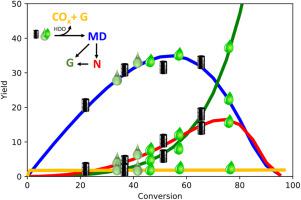Applied Catalysis B: Environment and Energy ( IF 22.1 ) Pub Date : 2021-11-20 , DOI: 10.1016/j.apcatb.2021.120911 Donia Bouzouita 1 , Aleksandra Lelevic 1, 2 , Chantal Lorentz 1 , Robbie Venderbosch 3 , Thomas H. Pedersen 4 , Christophe Geantet 1 , Yves Schuurman 1

|
Hydrocracking converts heavy feeds mainly into middle distillate products. Co-processing these bio-feeds with vacuum gas oil is a possible production route for biofuels. Stabilized bio-liquid from fast pyrolysis and hydrothermal liquefaction bio-crude were mixed with vacuum gas oil (10–20 wt%) and hydrocracked over a bifunctional catalyst. The impact of the bio-liquids on conversion and middle distillate selectivity were investigated. The liquid products were analyzed by several methods such as 2-dimensional gas chromatography coupled with simulated distillation to obtain quantitative distribution of monoaromatics, polyaromatics and saturated hydrocarbons. A quantification study of different types of carbons was performed by 13C NMR and showed the evolution of products. The nature of bio-liquid impacts slightly on the conversion and gas production but not on the selectivity of middle distillates and naphtha. This is explained by a decoupled hydrodeoxygenation and hydrocracking process. This also resulted in a high hydrodesulfurization conversion.
中文翻译:

加氢裂化与减压瓦斯油协同处理生物液体
加氢裂化主要将重质原料转化为中间馏分产品。将这些生物原料与真空瓦斯油共同加工是生物燃料的可能生产路线。来自快速热解和水热液化生物原油的稳定生物液体与真空瓦斯油(10-20 wt%)混合,并在双功能催化剂上加氢裂化。研究了生物液体对转化率和中间馏分选择性的影响。通过二维气相色谱结合模拟蒸馏等多种方法对液体产物进行分析,以获得单芳烃、多芳烃和饱和烃的定量分布。不同类型碳的量化研究由13C NMR 并显示产物的演变。生物液体的性质对转化率和产气量有轻微影响,但对中间馏分油和石脑油的选择性没有影响。这可以通过分离的加氢脱氧和加氢裂化过程来解释。这也导致高加氢脱硫转化率。



























 京公网安备 11010802027423号
京公网安备 11010802027423号